
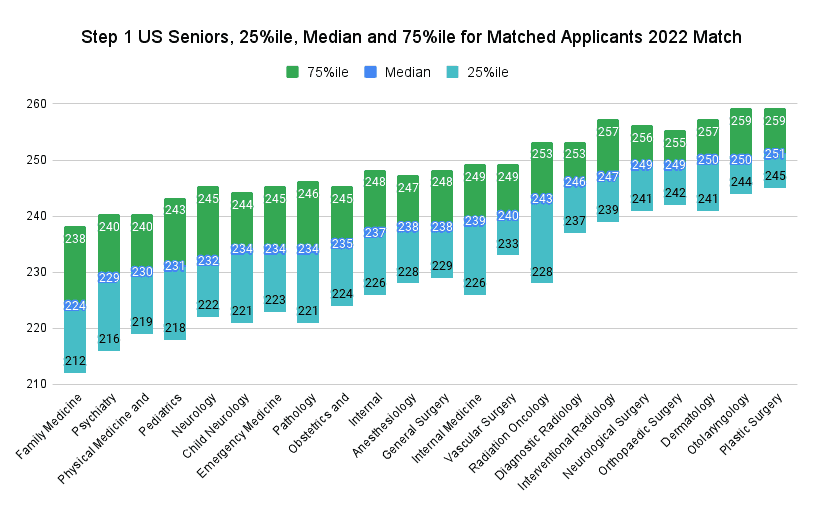
Have you ever wondered what a good Step 1 score was? What percentile is a 240 on Step 2 CK? Step 1 percentile cut-offs to get a residency interview? What score do you need to match into any specialty? If so, you’ve come to the right place.
Here, we look at what exactly a “good” USMLE score is. Most med students have heard that a Step 1 score of 240 is “good.” A 250 is “really good.” While those are good starting points, the story is more nuanced than that. With Step 1 becoming pass/fail, more focus is being put on Step 2
Specifically, in this article, we will address:
- Percentiles for Step 1, Step 2 CK, and Step 3
- Minimum cut-offs for each NRMP specialty (get these scores if you don’t want to get screened out)
- Scores needed to get interviews at most programs
- Step 1 and Step 2 CK scores for matched applicants to each specialty
Note: Updated with new data for 2025: This article now includes the latest data from the 2024 Charting Outcomes in the Match for US Seniors and IMGs, as well as the 2024 NRMP Program Direct Survey.
Table of Contents
Percentiles for Step 2 CK, and Step 3 in 2024
The easiest way to answer what a “good” score is to look at the percentiles of all test-takers. Specifically, we can look at the percentiles for USMLE, as reported by the NBME. Here are the percentiles for Step 1, Step 2 CK, and Step 3:
| Score | Step 2 CK Percentile | Step 3 Percentile |
|---|---|---|
| 300 | 100 | 100 |
| 295 | 100 | 100 |
| 290 | 100 | 100 |
| 285 | 100 | 100 |
| 280 | 100 | 100 |
| 275 | 99 | 100 |
| 270 | 95 | 100 |
| 265 | 87 | 100 |
| 260 | 76 | 99 |
| 255 | 63 | 97 |
| 250 | 50 | 93 |
| 245 | 37 | 87 |
| 240 | 26 | 79 |
| 235 | 18 | 68 |
| 230 | 12 | 55 |
| 225 | 7 | 42 |
| 220 | 4 | 30 |
| 215 | 2 | 19 |
| 210 | 1 | 12 |
| 205 | 1 | 7 |
| 200 | 0 | 3 |
| 195 | 0 | 2 |
| 190 | 0 | 1 |
| 185 | 0 | 0 |
| 180 | 0 | 0 |
| 175 | 0 | 0 |
| 170 | 0 | 0 |
| 165 | 0 | 0 |
| 160 | 0 | 0 |
| 155 and below | 0 | 0 |
Here is the same data represented visually:
And graphed as a distribution curve:
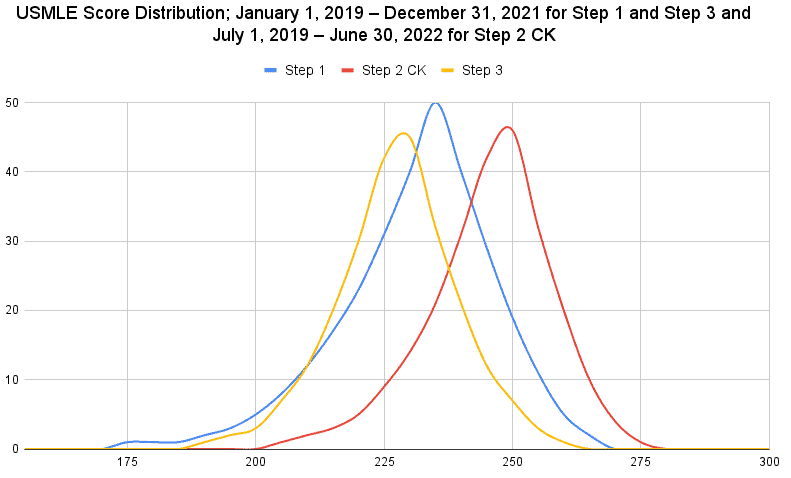
USMLE Step 1, Step 2 CK, Step 3 Percentiles
What do you notice?
First, Step 2 CK scores are significantly higher than Step 3 scores. So a 255 on Step 2 is the 63th percentile. However, it would be the 97th percentile for Step 3.
One reminder: med students are excellent test-takers. For example, the average MCAT score is roughly 500, with a standard deviation of 10.5. However, the average MCATs of matriculants is approximately one standard deviation higher! In other words, the average matriculant’s MCAT is in roughly the 80%ile of test-takers.
Translation: an “average” US med student scored higher than 80% of MCAT test-takers. Thus, you have to do much better to achieve the same percentile on Boards as you did on the MCAT. (Not to mention the fact that you get to take each USMLE only once).
What Are Each Specialty’s USMLE Cut-Off Scores for Interviews?
Most people view USMLE scores not as an end in itself. Instead, they are a means to a particular aim, specifically residency applications.
Residencies use Boards scores as a significant criterion in selecting applicants. Often Step 1 is the most cited criteria used for extending residency interviews. In fact, many programs use it as a “screen” for applicants. It’s used so often, in fact, that many residencies have cut-off scores. For example, in the 2020 PD survey, 55% of respondents report a “target” Step 1 score. In contrast, only 36% reported having a “target” Step 2 CK score. You can see the USMLE Step 2 score range for your specialty below.
Here are each specialty’s cut-off scores from the most recent program director survey. These are the Step 1 Scores “Below Which Programs Generally Do Not Grant Interviews”:
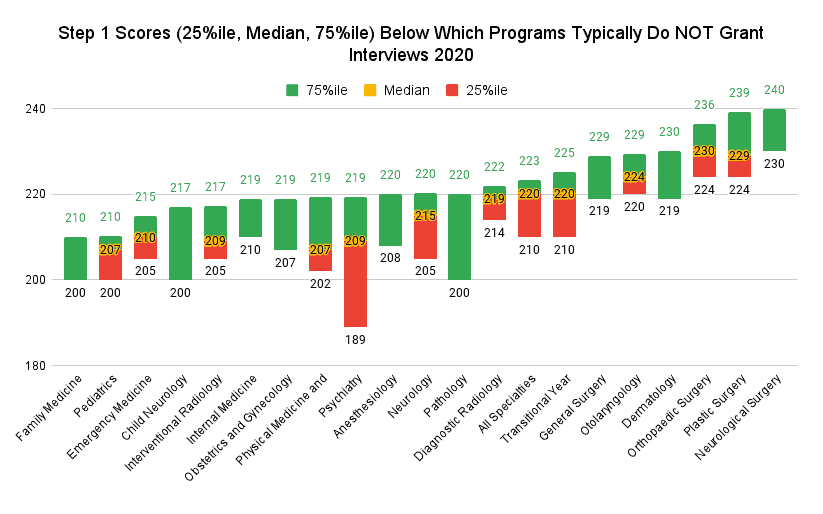
Step 1 Scores (25%ile, Median, 75%ile) Below Which Programs Typically Do NOT Grant Interviews, 2022 Program Director Survey
And the Step 2 CK percentile cut-off scores for interviews:
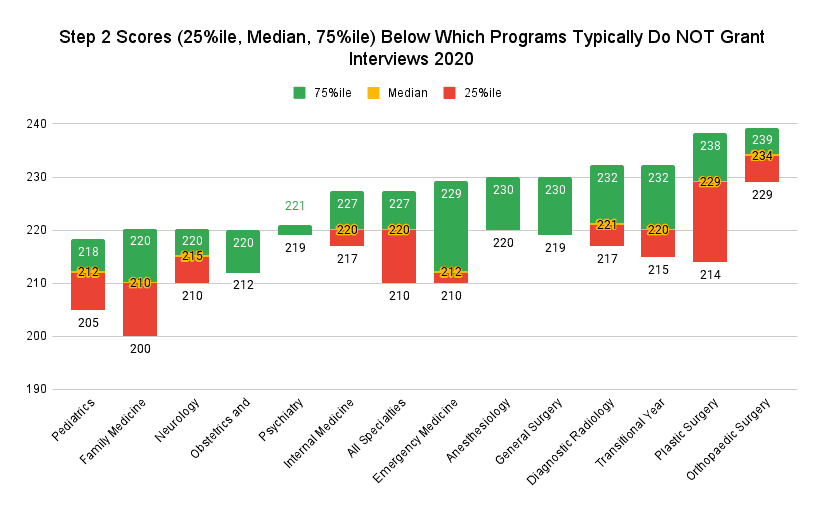
Step 2 Scores (25%ile, Median, and 75%ile) Below Which Programs Typically Do NOT Grant Interviews; 2020 Program Director Survey. * Median Cut-Off Scores Not Available for All Specialties
What Score Will Virtually Guarantee an Interview?
Programs use USMLE scores as cut-offs for interviews. Similarly, they also may extend an interview based solely on high Boards scores.
Programs also reported scores above which they would “Almost Always Grant Interviews.” We went through and collected the 25%ile, median, and 75%ile scores. In other words, the median scores for Step 1 mean that 50% of programs with a target score would “almost always” grant you an interview. Similarly, the 75%ile score means that 75% of the programs would almost always grant you an interview based on your score alone.
Here are the Step 1 percentiles to maximize your interview chances:
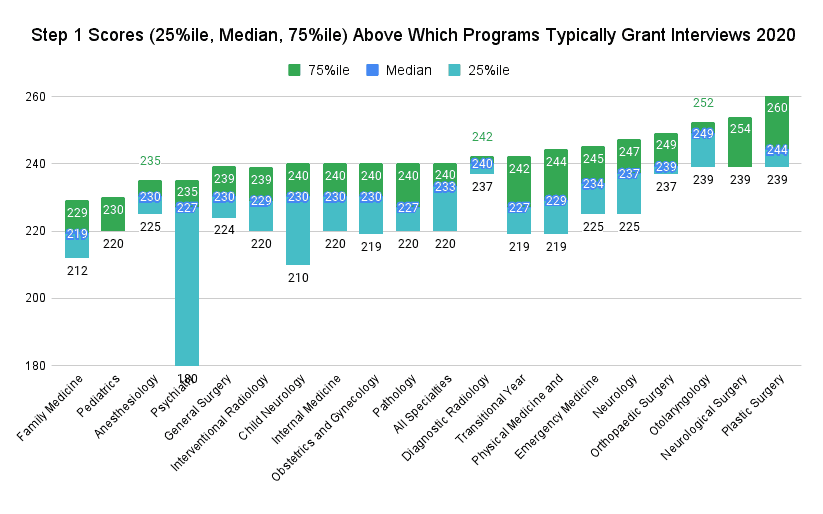
Step 1 Scores (25%ile, Median and 75%ile) Above Which Programs Almost Always Grant Interviews; 2020 Program Director Survey
And the Step 2 CK percentiles give you the greatest chance at interviewing:
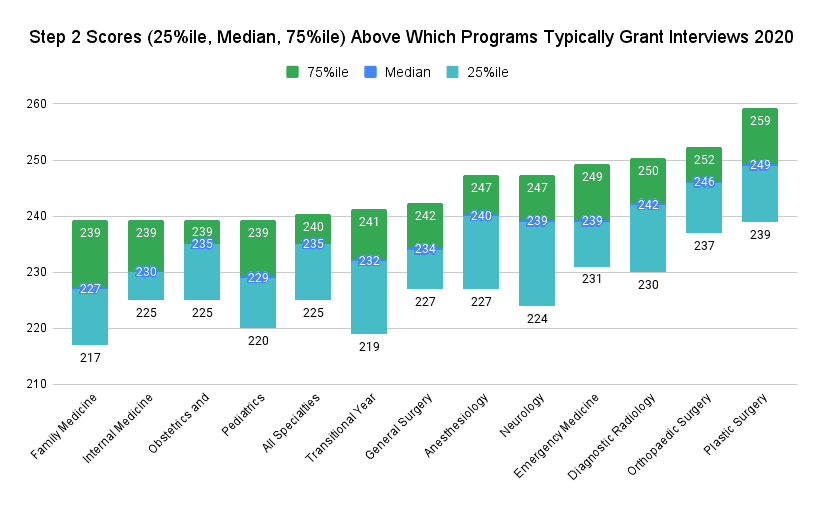
Step 2 CK Scores (25%ile, Median and 75%ile) Above Which Programs Almost Always Grant Interviews; 2020 Program Director Survey
What do you notice? First, if you’re aiming for an interview, a 240 on Step 1 will get you in the door with programs that aren’t the most competitive. For the next tier up, you might want to aim for a Step 1 score of 250. And for ENT, neurological surgery, and plastic surgery? A 260 would get you an interview at most programs that grant interviews based on high USMLE scores.
How Many Residency Programs Have Step 1 and Step 2 CK Cut-Off Scores?
So how many programs have actual cut-off scores for granting residency interviews? 55% of the PD survey respondents reported having a Step 1 “target score.” Only 43% of 2018 respondents claimed not to have a “target” Step 1 score. Discussions with admissions committee members would corroborate this.
Two (Small) Caveats to the Step Percentile Cut-Offs for Interviews
After looking at the data for interview cut-offs, there are two small caveats. First, with any surveys, you have to consider the response rate. The NRMP sent out 5,143 surveys, and 924 programs responded. Less than 1/5 of the programs responded with a response rate of 18.0%.
Second, a small number of programs reported having a “target” score, but not all of them said what that score was. For example, of the 924 respondents, only 655 reported whether or not they required a cut-off Step 1 score. Of these, only 337 specified their cut-off score (implying roughly 4% claimed to have a target score but didn’t specify it). Even fewer reported their Step 2 CK cut-off score. Out of 651 respondents, 36% reported having a target Step 2 CK score, but only 29% specified what that score is.
What about the “Scores Above Which Programs Almost Always Grant Interviews” question? 281 programs responded with a Step 1 score. And 171 respondents specified a Step 2 CK score.
The reported score cut-offs for getting interviews in each specialty are useful information. Like everything, however, take these scores with a grain of salt.
Step 1 and Step 2 CK Scores for Matched Applicants to Each Specialty in 2022
Board scores are vital ingredients to getting an interview. As such, it’s no surprise that successful applicants have higher scores. Here are the 25%ile, median, and 75%ile Step 1 scores for matched applicants in each specialty.
(Note: unlike the program directors survey, these numbers come directly from the NRMP. In other words, as far as I can tell, the numbers encompass all programs.)
We’ll start with Step 1 percentiles for matched US Seniors:
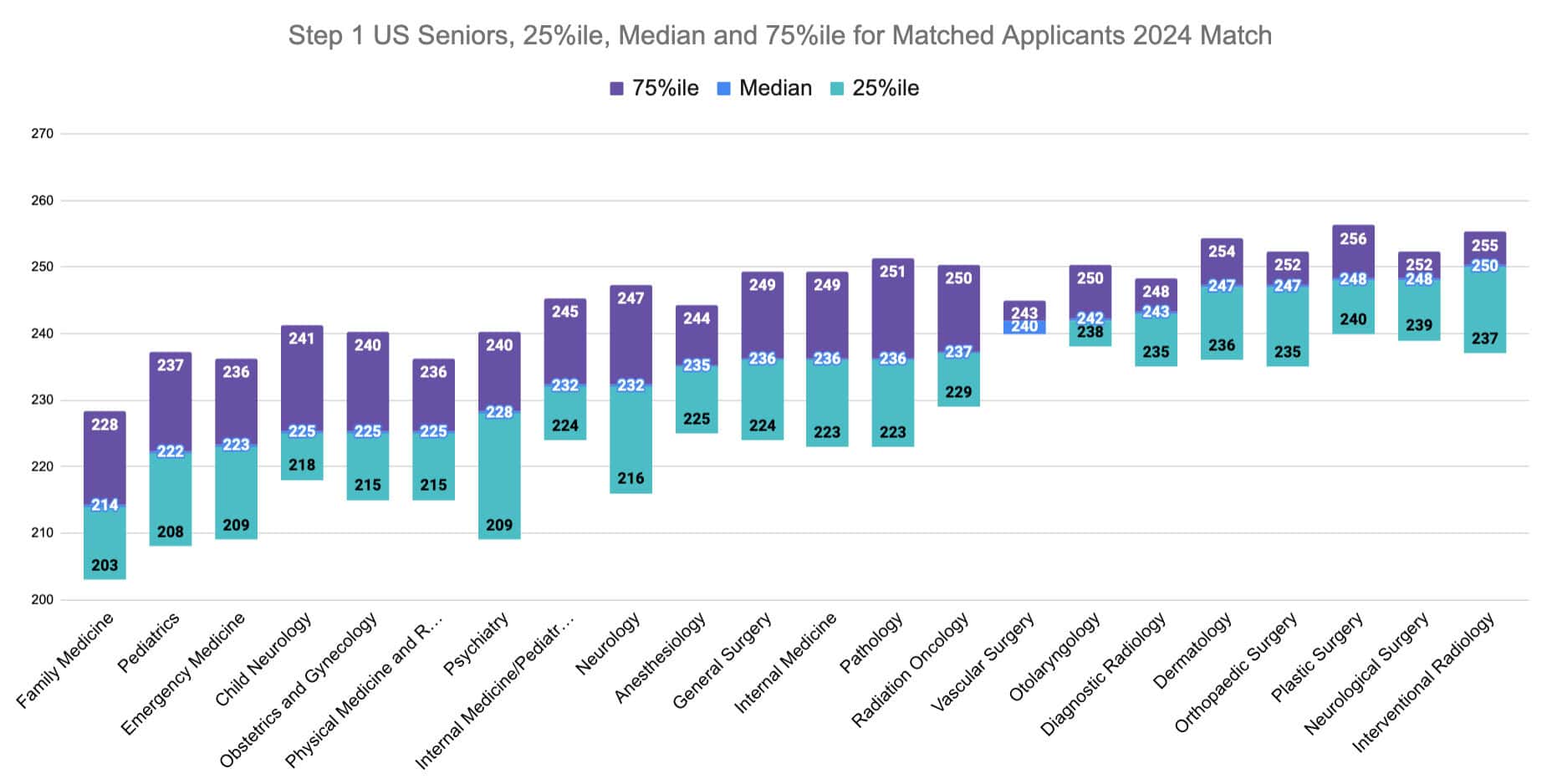
Step 1 US Seniors, 25%ile, Median and 75%ile for Matched Applicants 2024 Match
Here are the Step 1 percentiles for matched US and Non-US IMGs. (Note: not all specialties had enough matched applicants to generate ranges).
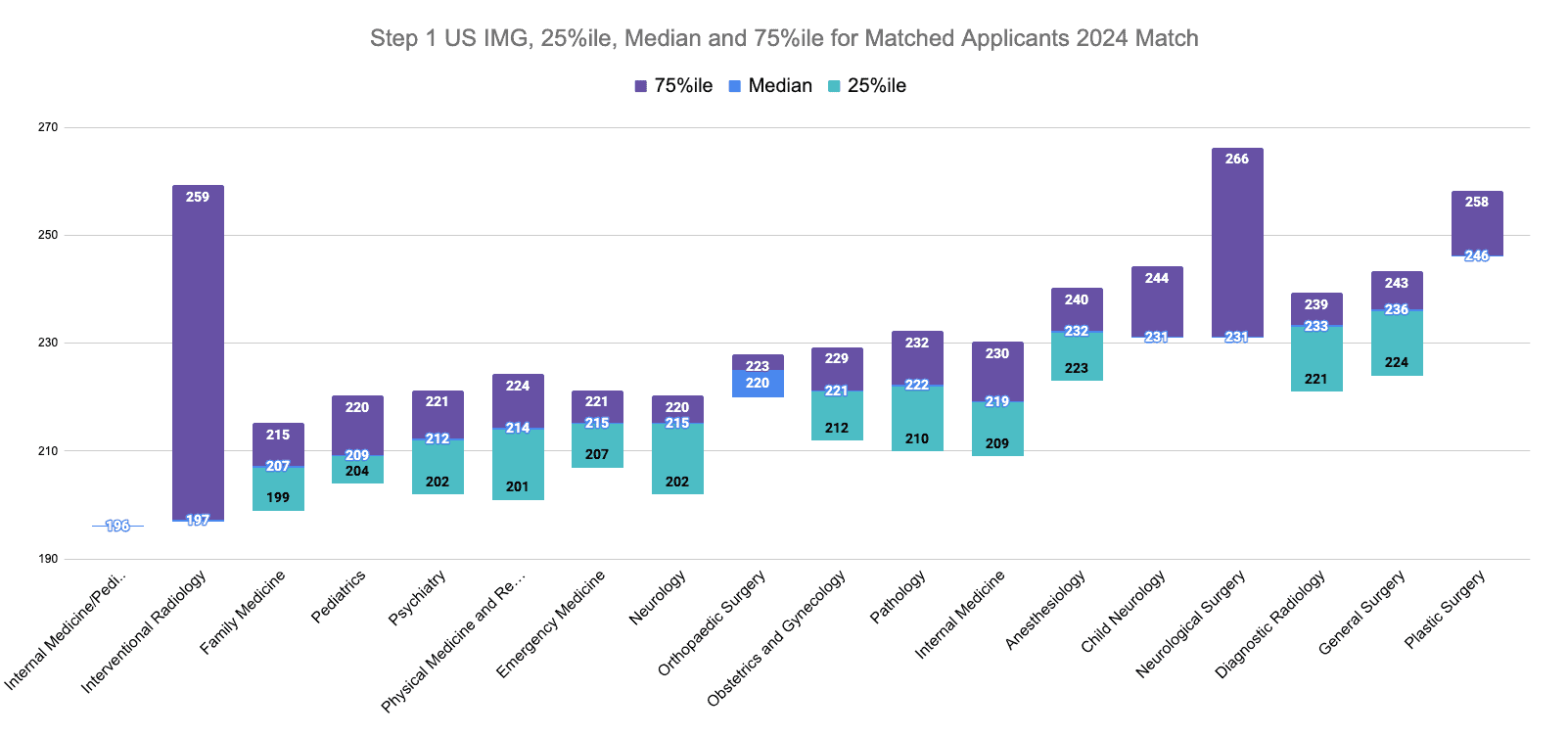
Step 1 US IMGs, 25%ile, Median and 75%ile for Matched Applicants 2024 Match
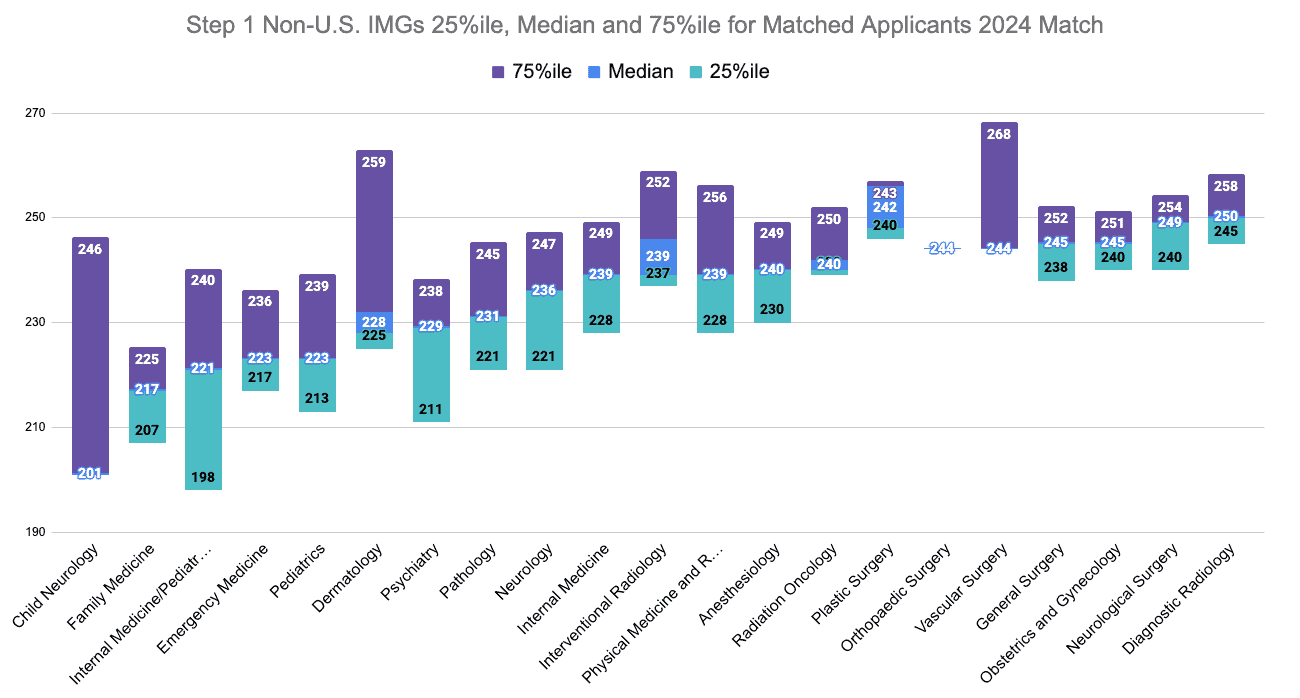
Step 1 Non-US IMGs, 25%ile, Median and 75%ile for Matched Applicants 2024 Match
Here are the 25%ile, median, and 75%ile Step 2 CK scores for matched applicants in each specialty.
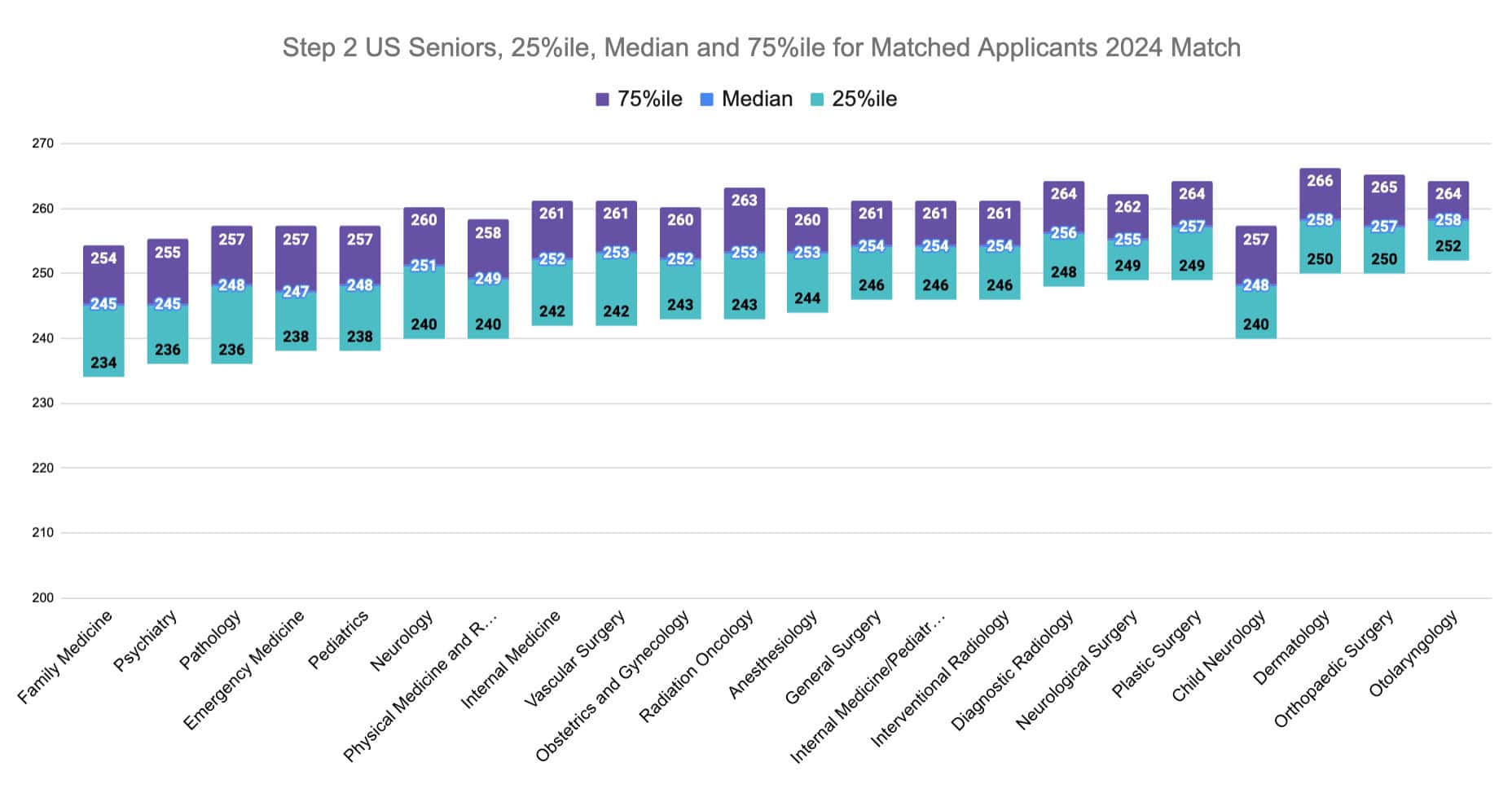
Step 2 CK US Seniors, 25%ile, Median and 75%ile for Matched Applicants 2022 Match
And the same Step 2 CK percentiles for US and Non-US IMGs:
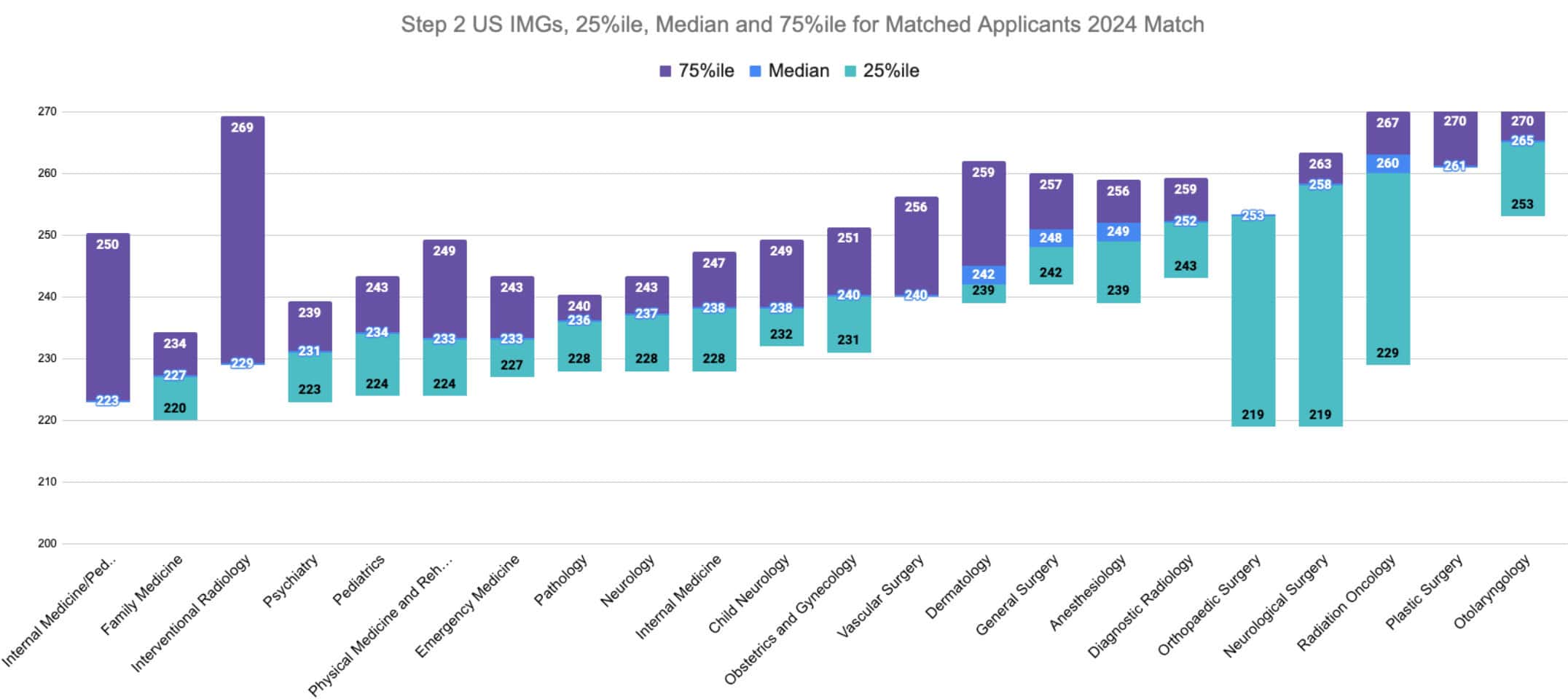
Step 2 CK US IMGs, 25%ile, Median and 75%ile for Matched Applicants 2024 Match
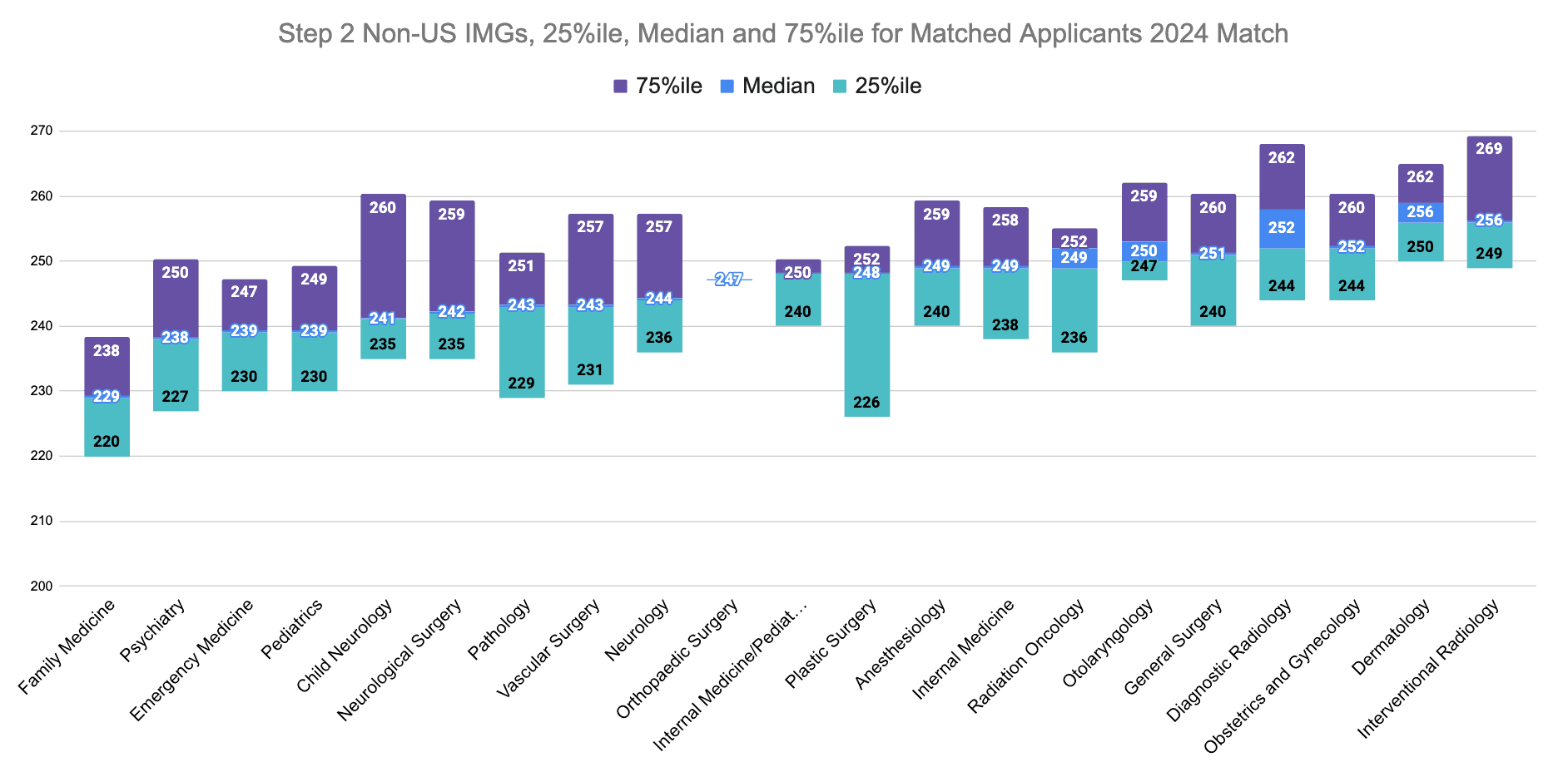
Step 2 CK Non-US IMGs, 25%ile, Median and 75%ile for Matched Applicants 2024 Match
Matched IMG Scores May Be Lower Than You Expect
As discussed above, previously top students may struggle to achieve average USMLE scores. (Remember, this makes sense; roughly 50% of students will score below-average). This is doubly true for IMGs. It’s not uncommon to see non-US IMGs who were top students in their country struggle to get an average Step 1 score. Why?
There are several reasons non-US IMGs may achieve lower-than-expected USMLE percentiles. First, their home country curriculum may emphasize very different things. For example, most non-US medical schools teach little to no basic science. Things like biochemistry, microbiology, or immunology may get little emphasis.
Second, many non-US IMGs take Step 1 years after they’ve learned the material. Finally, most non-US IMGs have never taken exams like the USMLEs. Virtually every foreign graduate I’ve tutored describes national exams as memorization-heavy. They’ve never had to master a concept, then apply it to a clinical vignette.
IMG or not, if you struggle to master and apply key concepts, there is hope. It’s not easy, but you can learn mastery of these concepts. Read more about students who mastered the material to get their dream residencies:
- From 136 to Step 1 247: Conquer Memorization for Impressive Boards Scores
- How this Caribbean IMG Got Her Top Choice “ROAD” Residency
- I Scored 258 on Step 1 in 6 Weeks. Here’s How You Can Do Better.
- From USMLE Step 1 226 to Step 2CK 260: Prevent/Overcome an Average Step 1 Score
- Want to Add 20-60+ Points to Step 1? Here’s How Long It Takes (16 Experiences)
High Scores Are Necessary But Not Sufficient for the Most Competitive Specialties
What do you notice from the scores of matched applicants? You might conclude good Boards scores are all you need. However, you’d be wrong.
Why? Because the scores of unmatched applicants in competitive specialties are often quite high. For example, for interventional radiology, the Step 1 25%ile of unmatched US seniors in 2024 was 232. 231 was higher than the median matched score for seven specialties! Let’s look at the USMLE Step 1 score range below for your specialty.
Here are the 25%ile, median, and 75%ile for unmatched US seniors in the 2022 Match. In other words, these are the scores of applicants who did NOT match into each specialty.
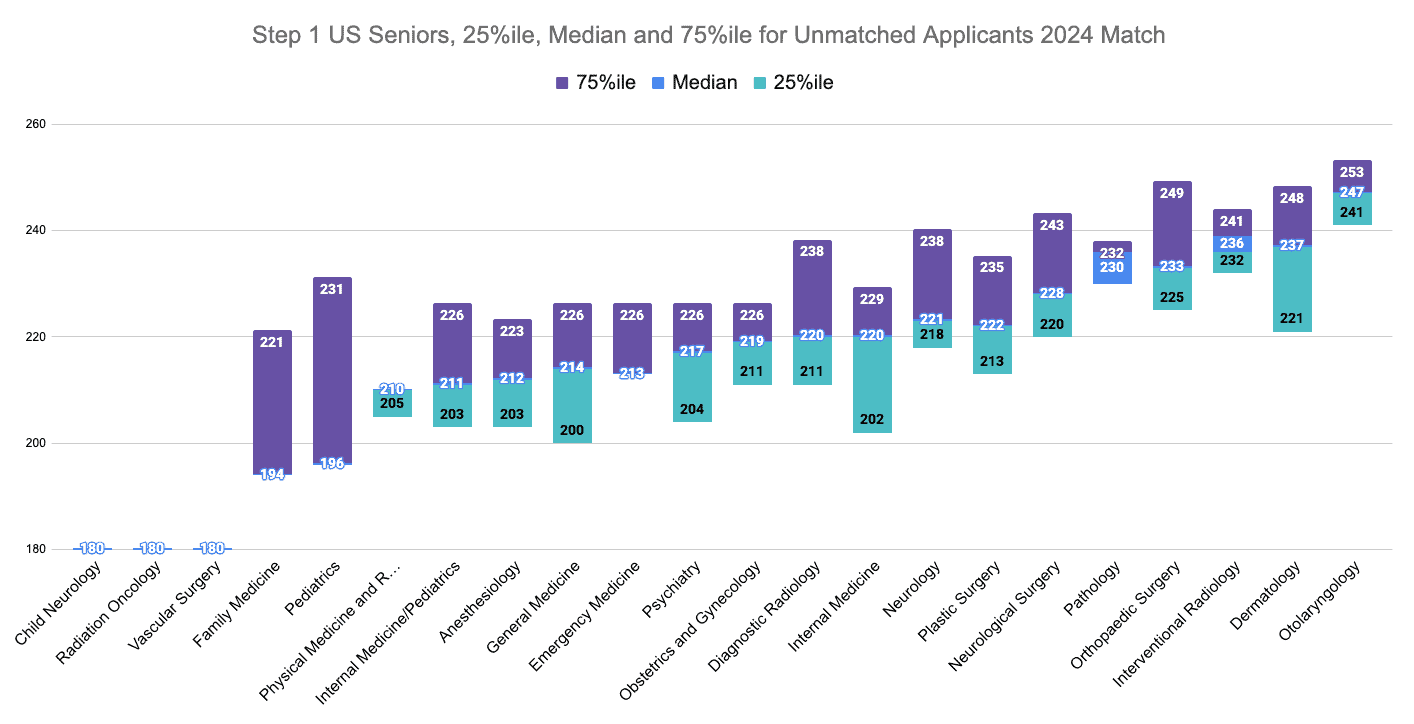
Step 1 US Seniors, 25%ile, Median and 75%ile for Unmatched Applicants 2024 Match
Unmatched Applicants Have Similar Scores to Matched Applicants for the Most Competitive Specialties
We can also compare the median scores between matched and unmatched applicants. When we do so, a different picture emerges.
Here are the inter-median differences for US Seniors in the 2024 Match. Specifically, I subtracted the median for unmatched 2024 applicants from their matched cohorts. In other words:
- The median Step 1 score for matched dermatology applicants in 2024 was 247.
- The median for unmatched dermatology applicants was 237.
- The difference between the two was 10 points!
Here are the inter-median Step 1 scores for 2024 applicants by specialty for US seniors.
Here are the inter-median Step 2 CK scores by specialty for US seniors.
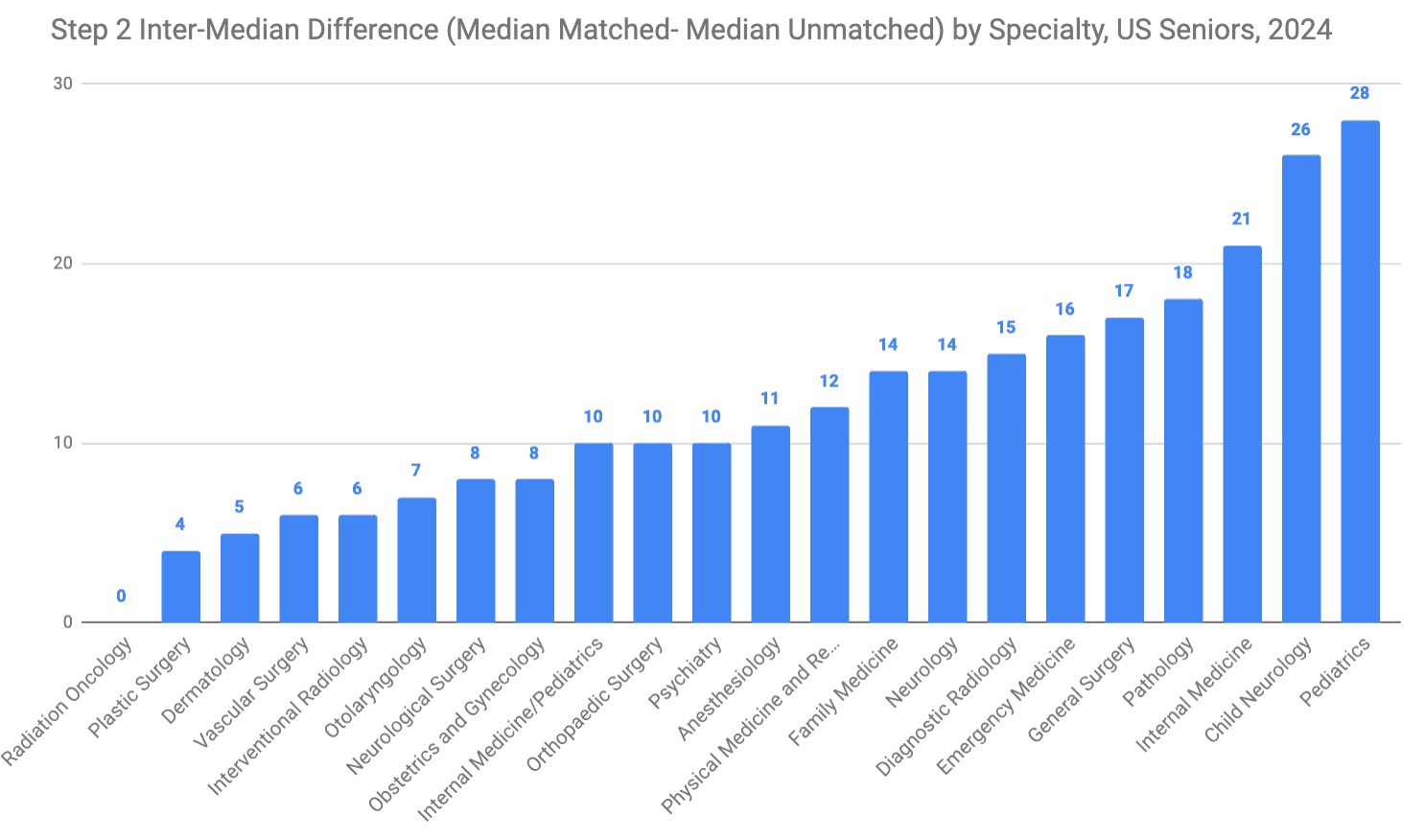
(To read Get Into a Top Residency: 5 Things You Need to Know, click here).
Concluding Thoughts
A “good” USMLE Step 1 result now simply means a pass. Want to get into a less competitive specialty? Passing Step 1 might be sufficient alongside a solid Step 2 CK score. Aiming for orthopedic surgery at a prestigious academic center? With Step 1 now pass/fail, your Step 2 CK performance will play an even bigger role in keeping those doors open.
That said, there are ranges in scores for a reason. Your USMLEs will be one (albeit important) part of your application. With enough hard work, connections, and ingenuity, few doors are truly closed. Knowing the kinds of scores programs look for is one piece of a larger puzzle.
What do you think? Were the various score percentiles what you expected? Anything about the statistics surprise you? Let us know in the comments!

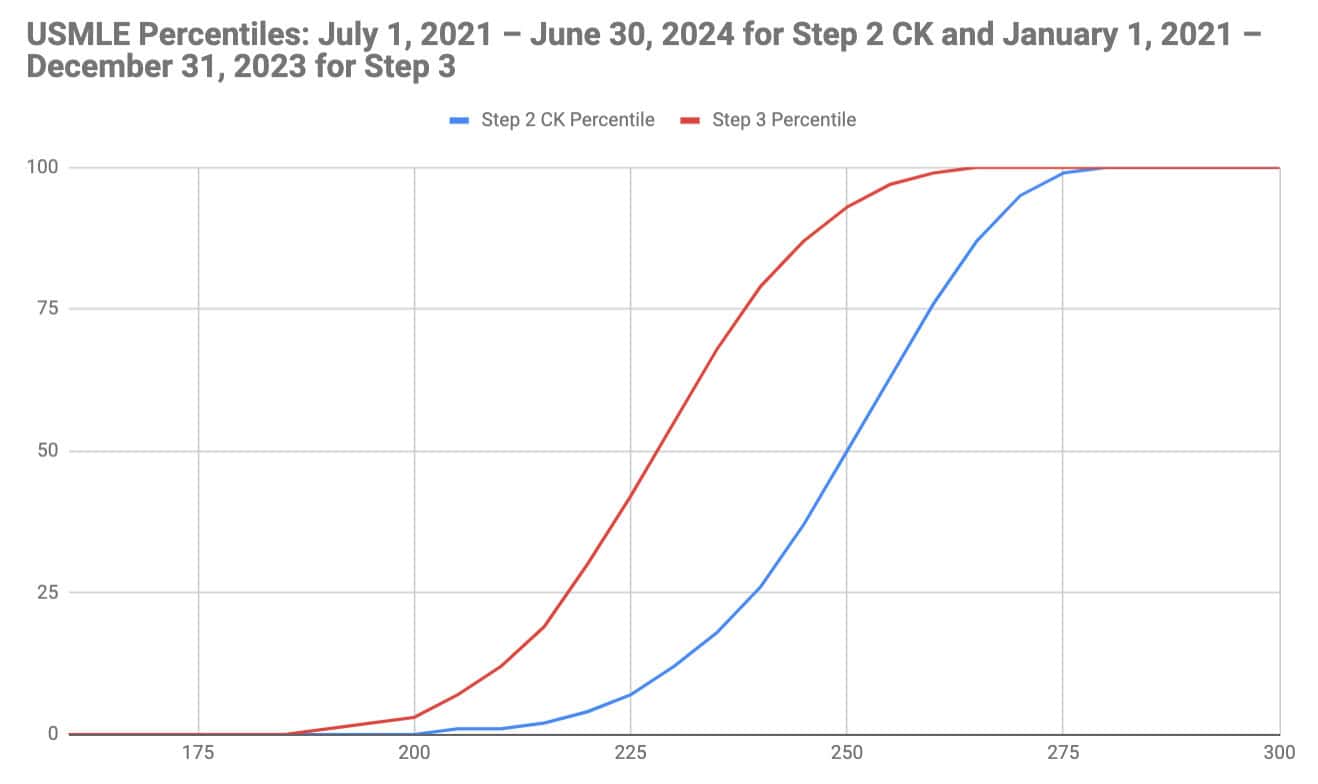
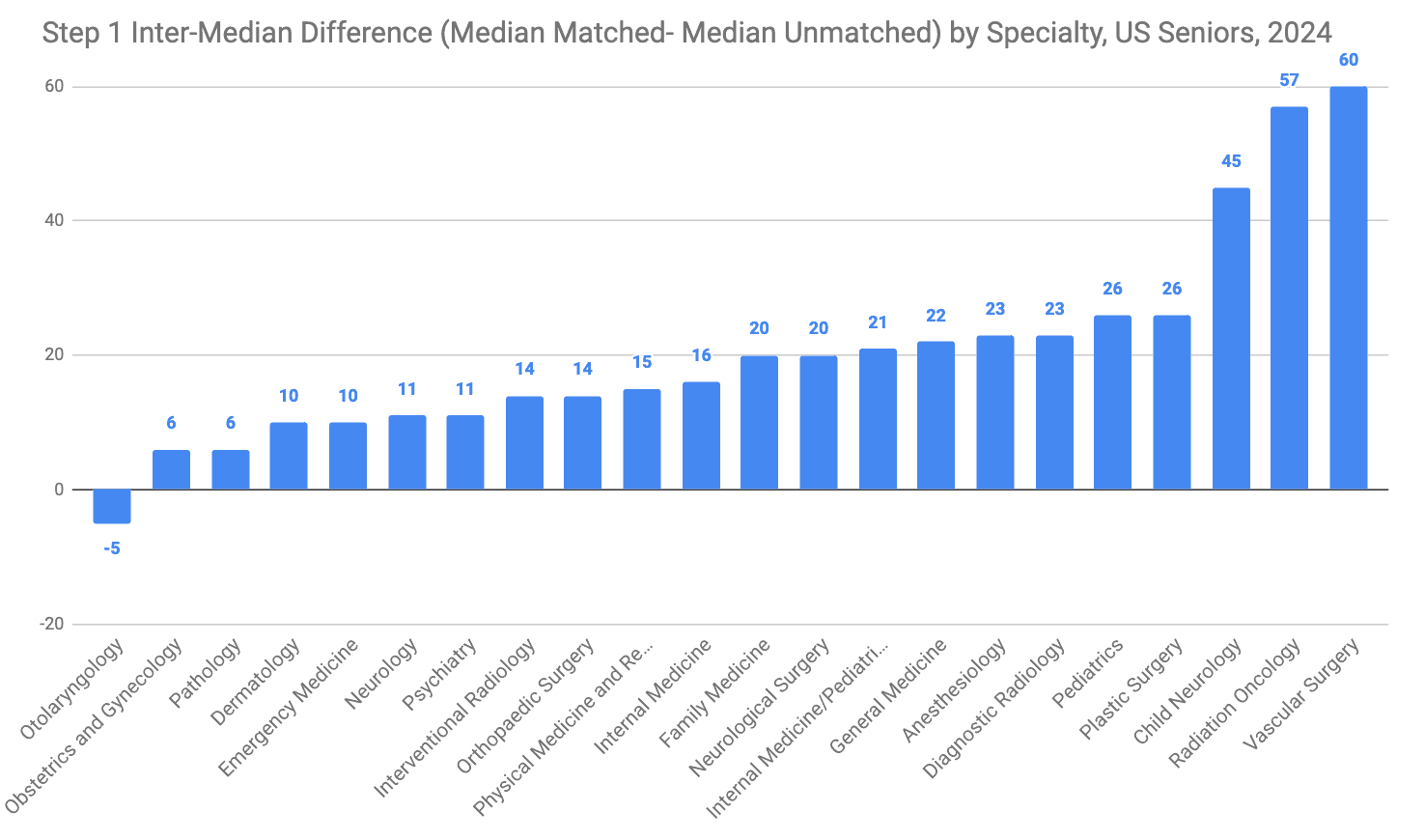







How important is the year of graduation for non-US IMGs for matching purpose? Is there a certain amount of year since graduation beyond which the matching algorithms automatically kick you out as an IMG? Thanks
Great question. I know of no automated way to do that, although I think there is greater reluctance on program directors part the longer you’ve been away, unless you have a particularly compelling reason why. That said, little is black and white and so my guess a lot of it depends on your particular situation / the programs you are interested in.
may you please explain how many correct questions you need for each three number grade is ? – med student
The USMLE/NBME has not released that information publicly, and even if it were public, the internal scale for each exam will likely be different, as they are for each NBME Self Assessment.